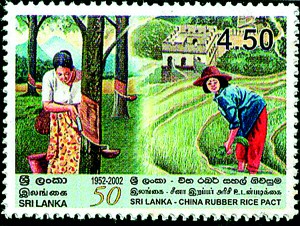The stamp issued to mark the historic Rubber-Rice Pact between Sri Lanka (then Ceylon) and the People’s Republic of China signed on December 18, 1952.
Recently, Chinese Foreign Minister Wang Yi paid a visit to Sri Lanka to commemorate the 65th year of bilateral ties between the two countries, but another landmark history remained silent over the warm visit -70th anniversary of historic Rubber- Rice pact.
The accord is widely regarded as one of the world’s most successful and long-lasting trade agreements. Despite the agreement bgein terminated in 1982, the spirit of the accord symbolizes the vitality of Sino-Lanka bilateral ties.
The Ceylon-China Commercial Agreement of 1952 was unquestionably one of the most beneficial trade deals ever negotiated between China and Sri Lanka, and it exemplified China’s open-minded diplomacy. The Western youth has a right to know about the ancient benign links between China and Sri Lanka, not simply the phony “Hambantota Debt Trap” rhetoric
Wang during his visit quoted “The spirit of the pact characterized by independence, self-reliance, Unity and mutual support is deeply rooted in the heart of two peoples’ and such spirit should be carried forward’’.
1952 was a bad year for Sri Lanka; the country faced a global rice scarcity because rice from the country’s regular suppliers, Burma, Thailand, and Indo-China were unavailable. Between 1951 and 1952, the world market price of rice increased by 38 percent.
In 1952, the Lankan government faced a foreign exchange crisis as a result of a sharp drop in export prices precipitated on the rapid end of the Korean War boom. Between 1951 and 1952, Sri Lanka’s export price fell by 23 percent as a result of the West’s reduced acquisition of commodities, particularly natural rubber by the USA, resulting in a trade surplus of Rs 345 million in 1951 turning into a trade deficit of Rs 200 million in 1952.
In that desperate position, Sri Lanka attempted, but failed, to arrange a loan of $50 million from the USA, as well as favorable rates for a few rubber exports and rice imports. Moreover, she was forced to buy 60,000 tons of rice from the USA at a hefty price since she couldn’t find enough rice to feed her people.
However, in 1952, China agreed to sell rice to Sri Lanka in exchange for rubber, and the “Rubber-Rice Pact” was signed. China was also in need of rubber at that time, as she was unable to receive it due to a ban on rubber export from Malaya imposed by a United Nations resolution prohibiting the sale of rubber to communist China.
China promised to pay a higher price for rubber than the market price and to deliver rice to Sri Lanka at a lower price than the market price. As a result, the agreements benefited Sri Lanka in both directions. Even when other markets were willing to offer rubber at a cheaper price, China continued to buy it at a premium. Even when she didn’t have an exportable surplus, China supplied Sri Lanka with rice directly from Burma under triangle trade agreements, charging only the amount she paid Burma, not a penny more —even when she had incentive to charge more.
The US government retaliated by enacting the “Battle Act,” which resulted in the suspension of aid to Sri Lanka without taking into account the country’s precarious economic situation. She also ceased distributing sulphur, which is required by Sri Lanka’s Rubber Plantation.
“We noted on the Chinese side the absence of the spirit of bargaining and arguing on fairly trivial things,” said RG Senanayake, Sri Lanka’s then Trade and Commerce Minister. “ They gave us the sense, on the other hand, of being open-minded and frank in their dealings.”
Sri Lanka has also been dealing with a serious financial and foreign exchange crisis in recent years, which has been exacerbated by the loss of tourist income during the pandemic. According to the Chinese Ambassador to China, “China has already assisted and will continue to support”. The China Development Bank (CDB) already offered a $500 million loan and another loan of 2 billion Chinese yuan in 2021.The two central banks signed a currency swap for 10 billion yuan which is equal to $1.5 billion.
Within March, 2022, Sri Lanka will receive 1 million metric tons of rice as a contribution from China, according to Co-Cabinet spokesman Minister of Sri Lanka Ramesh. The gift is being made to commemorate the 70th anniversary of the Rubber-Rice Pact.
The Chinese Debt Trap propaganda over Sri Lanka is always promoted by the Western media. The “Hambantota Myth” is being used to hide Sino-Lanka supportive diplomacy. According to western propaganda, Sri Lanka was unable to repay the money used to build the port, therefore it was given over to China. However, because the port was losing money under government control, the Sri Lankan government chose to lease an 85 percent part in the port to China Merchants Ports Holding Company in order to raise foreign currencies in 2016. The $1.12 billion received from China Merchant Ports was used to boost Sri Lanka’s US-dollar reserves and pay off short-term foreign debts unrelated to the port, primarily foreign bond interest.
The Ceylon-China Commercial Agreement of 1952 was unquestionably one of the most beneficial trade deals ever negotiated between China and Sri Lanka, and it exemplified China’s open-minded diplomacy. The Western youth has a right to know about the ancient benign links between China and Sri Lanka, not simply the phony “Hambantota Debt Trap” rhetoric.























